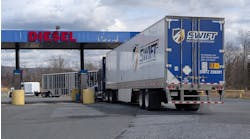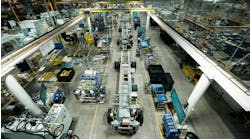Progressively stricter federal emissions standards aimed at U.S. trucking are less than three years away and, according to detractors, could drive the transportation industry off a cliff.
The Environmental Protection Agency’s Greenhouse Gas Emissions Standards for Heavy-Duty Vehicles-Phase 3, known as GHG3, aims to combat climate change. Beginning with model year 2027 equipment, truck and engine manufacturers must make a certain number of zero-emission vehicles, which include battery-electric and fuel cell-electric vehicles.
For example, to satisfy 2032 emissions goals, 25% of an OEM’s long-haul (sleeper cab) tractors and 40% of its short-haul (day cab) trucks should not produce any tailpipe emissions. GHG3 begins taking effect with MY 2027, with light heavy-duty vocational needing 17% ZEV sales and medium heavy-duty vocational needing 13%. By MY 2032, these shares would need to be at 60% and 40%, respectively.
Among the federal rule's detractors are Congressional Republicans, American Trucking Associations, Owner-Operator Independent Drivers Association, and many fleet leaders, who all voiced serious concerns over the current aggressive timeline.
See also: Making charging infrastructure a non-issue along the West Coast
One of those fleet leaders is Taki Darakos, VP of vehicle maintenance and fleet service at Pitt Ohio, as well as chairman of the Technology & Maintenance Council’s S.11 Sustainability & Environmental Technologies Study Group, who addressed the United States House of Representatives Committee on Transportation and Infrastructure Subcommittee on Highways and Transit on April 30.
Pitt Ohio, a less-than-truckload carrier operating from the Midwest to the East Coast, boasts a fleet of 950 company-owned tractors, 2,900 trailers, and 600 straight trucks. In its commitment to sustainability, the fleet has tested Volvo's VNR Electric in regional hauls around Cleveland. Additionally, the terminal has acquired Freightliner's eM2, a medium-duty battery-electric straight truck. The terminal is equipped with solar panels and innovative narrow wind turbines, making it a model of sustainability in the industrial suburb of Parma, Ohio.
“Although we continue to be optimistic about the promise of electrification in medium- and heavy-duty vehicles, we continue to encounter challenges related to costs, vehicle range, durability, and charging infrastructure that complicate broader deployment of heavy-duty battery-electric trucks,” Darakos stated.
If large fleets, such as Pitt Ohio, are struggling, that might not bode well for smaller fleets and the trucking industry as a whole because, according to the DOT, 99.7% of U.S. fleets operate fewer than 100 trucks.
“A major flaw is following the lead of the California Air Resources Board, which effectively will ban the sales of diesel trucks in the state by 2036,” writes John Hitch, editor-in-chief of Fleet Maintenance, a FleetOwner affiliate publication. “That might work in the Golden State, but the nation is a vast place, and federal mandates impact Parma and everywhere else from Juneau, Alaska, to Miami.”
Read more of Hitch’s deep dive into GHG3 and how fleets and other wary members of the trucking and transportation industries weigh in on how what they know and don’t know about how this restrictive regulation could impact the U.S. at FleetMaintenance.com.




